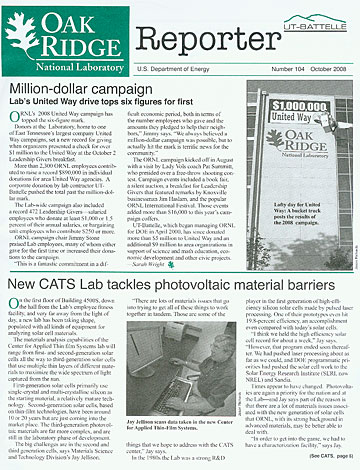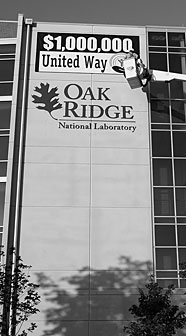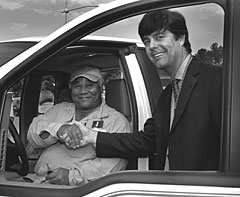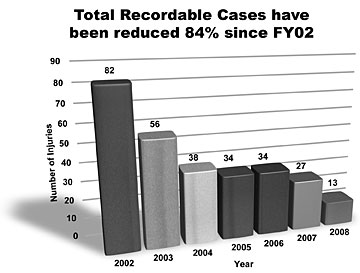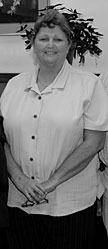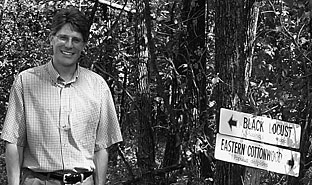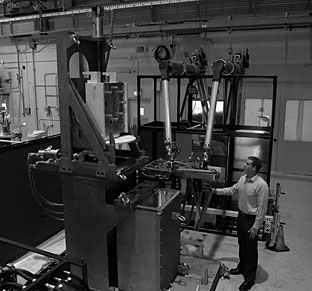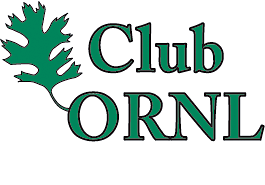 |
Number 104, October 2008 |
 Million-dollar campaign
Million-dollar campaign
Lab’s United Way drive tops six figures for first
|
|
Lofty day for United Way: A bucket truck posts the results of the 2008 campaign. |
ORNL’s 2008 United Way campaign has
topped the six-figure mark.
Donors at the Laboratory, home to one of East Tennessee’s largest company United Way campaigns, set a new record for giving when organizers presented a check for over $1 million to the United Way at the October 2 Leadership Givers breakfast.
More than 2,300 ORNL employees contributed to raise a record $890,000 in individual donations for area United Way agencies. A corporate donation by lab contractor UT-Battelle pushed the total past the million-dollar mark.
The Lab-wide campaign also included a record 472 Leadership Givers—salaried employees who donate at least $1,000 or 1.5 percent of their annual salaries, or bargaining unit employees who contribute $250 or more.
ORNL campaign chair Jimmy Stone praised Lab employees, many of whom either gave for the first time or increased their donations to the campaign.
“This is a fantastic commitment in a difficult economic period, both in terms of the number employees who gave and the amounts they pledged to help their neighbors,” Jimmy says. “We always believed a million-dollar campaign was possible, but to actually hit the mark is terrific news for the community.”
The ORNL campaign kicked off in August with a visit by Lady Vols coach Pat Summitt, who presided over a free-throw shooting contest. Campaign events included a book fair, a silent auction, a breakfast for Leadership Givers that featured remarks by Knoxville businessman Jim Haslam, and the popular ORNL International Festival. Those events added more than $16,000 to this year’s campaign coffers.
UT-Battelle, which began managing ORNL for DOE in April 2000, has since donated more than $5 million to United Way and an additional $9 million to area organizations in support of science and math education, economic development and other civic projects. —Sarah Wright ![]()
 New CATS Lab tackles photovoltaic material barriers
New CATS Lab tackles photovoltaic material barriers
On the first floor of Building 4500S, down the hall from the Lab’s employee fitness facility, and very far away from the light of day, a new lab has been taking shape,
populated with all kinds of equipment for analyzing solar cell materials.
|
Jay Jellison scans data taken in the new Center for Applied Thin-Film Systems. |
The materials analysis capabilities of the Center for Applied Thin film Systems lab will range from first- and second-generation solar cells all the way to third-generation solar cells that use multiple thin layers of different materials to maximize the wide spectrum of light captured from the sun.
First-generation solar cells primarily use single-crystal and multi-crystalline silicon as the starting material, a relatively mature technology. Second-generation solar cells, based on thin-film technologies, have been around 10 or 20 years but are just coming into the market place. The third-generation photovoltaic materials are far more complex, and are still in the laboratory phase of development.
The big challenges are in the second and third generation cells, says Materials Science and Technology Division’s Jay Jellison.
“There are lots of materials issues that go into trying to get all of these things to work together in tandem. Those are some of the things that we hope to address with the CATS center,” Jay says.
In the 1980s the Lab was a strong R&D player in the first generation of high-efficiency silicon solar cells made by pulsed laser processing. One of their prototypes even hit 19.8-percent efficiency, an accomplishment even compared with today’s solar cells.
“I think we held the high efficiency solar cell record for about a week,” Jay says. “However, that program ended soon thereafter. We had pushed laser processing about as far as we could, and DOE programmatic priorities had pushed the solar cell work to the Solar Energy Research Institute (SERI, now NREL) and Sandia.
Times appear to have changed. Photovoltaics are again a priority for the nation and at the Lab—and Jay says part of the reason is that there are a lot of materials issues associated with the new generation of solar cells that ORNL, with its strong background in advanced materials, may be better able to deal with.
“In order to get into the game, we had to have a characterization facility,” says Jay.
Over the past year, that’s what he’s been working on—assembling a first rate characterization facility for materials that will be used to make the next generation of high-
efficiency solar cells.
The shiny new lab has a collection of instruments that can be used to measure the maximum power, quantum efficiency, light beam induced current and myriad other characteristics that enable them to evaluate the promise of a potential solar cell material.
“One of the most important questions to answer about a solar cell is, how well does it behave as a function of the actual wavelength of the light that’s hitting it? Or, in other words, how many charges get to the external circuit compared with the number of photons that hit the solar cell?” says Jay.
Solar cell modules on the market today usually get between 10-15 percent efficiency. That low number is caused primarily by heat loss from short wavelength photons, reflection (that’s why modules often have a non-reflective layer) and electronic defects in the material. Connecting solar cells in series and parallel to make a module and getting the power to the external grid also result in some loss as the electricity generated has to travel along the wires and connections.
Electronic defects can make or break a solar cell’s ability to harvest energy from the sun and turn it into usable electricity. Materials science techniques may lead the way to better solar cells by helping to investigate electronic defects in new photovoltaic materials. “Minimizing these defects is critical to getting really high efficiency solar cells,” says Jay.
The tricky thing is detecting them. “Defects can be caused by a single atom,” he says.
Many of the tools for defect analysis are still being built, says Jay. The same technologies that he needs for electronic defect analysis also have applications in the fields of solid-state lighting, thin-film batteries and even radiation detection, another area where the Lab’s materials expertise plays well with the photovoltaics research goals.
“What I really want to do is to build our capability to look at electronic defects in materials—because they affect photovoltaics, but also because it can be very helpful for other fields as well,” Jay says. —Sarah Wright ![]()
 From one Herb to another
From one Herb to another
F&O Directorate marks its stellar safety performance with a drawing for a new pickup
|
Debban |
|
Lab Director Thom Mason congratulates Herbert Hodge on winning the new pickup truck. |
Transportation Services’ Herbert Hodge has been driving a 1977 Chevy Impala to work. Thanks to record-setting safety numbers showing that craft worker injuries at the Lab are at an all-time low, Herb now can make that drive in a new Ford F150 truck.
Almost 600 accident-free bargaining unit employees were eligible for the random drawing that determined the truck’s eventual owner. The group, assembled September 30 on the quad, held their breath while Facilities & Operations Director Herb Debban drew a name. Then came a “suspenseful pause.”
Said the F&O director: “There’s a very small fraternity that shares the name Herb, but here it is: Herbert Hodge.”
When Herbert Hodge heard his name, it took a few minutes for the message to get all the way down to his feet. “My legs weren’t moving at first. I couldn’t believe it,” says the new truck owner.
| Total recordable cases in the Facilities & Operations Directorate have been reduced 84 percent since Fiscal Year 2002. |
|
“Herb Hodge represents the bargaining unit workers who have posted the best safety record ORNL has ever seen. They have all done a great job paying attention to safety,” said Carl Wright, who leads the Atomic Trades and Labor Council at ORNL.
In addition to the drawing for the truck, supervisors of accident-free groups were eligible for a drawing for a $5,000 bonus. Sharon “Sissy” Jenkins of the Campus Support & Instrumentation Division won that reward.
|
Bonus winner Sissy Jenkins. |
Year-end statistics from ORNL’s Facilities & Operations Directorate, which is home to the laboratory’s bargaining unit work force, show that work-related injuries dropped 84 percent since 2002. The directorate had 82 recordable injuries in 2002, a number that dropped to only 13 in 2008.
“This year only 13 injuries—25 percent of ORNL’s total—came from this group of employees,” Herb Debban says. In previous years, craft employees often were the source of the majority of ORNL’s on-the-job accidents.
Injuries that result in restricted duty or lost time away have seen the most dramatic reductions, with 95 and 96 percent fewer occurrences since 2002. The previous low for lost time away statistics was four in 2006. This year only one has been reported, in comparison to a high of 28 in 2002. Restricted duty numbers have also declined steadily from 46 in 2002 to six in 2007 and two in 2008.
“To achieve such a great reduction in employee injuries requires continuous vigilance on the part of everyone, and I commend you all for your hard work and attention that makes the lab a safer place to work,” says ORNL Director Thom Mason.
Next year, F&O plans to continue the tradition of positive reinforcement for safe behavior by rewarding three injury-free employees and one manager with $5,000 gift cards. —Sarah Wright ![]()
 |
 At SNS: New instruments, publication
At SNS: New instruments, publication
Things are clicking along in the Spallation Neutron Source’s instrument bay. Two new instruments are coming on line: The Fundamental Neutron Physics Beamline and SEQUOIA. And analysis with another SNS instrument of the newly discovered iron-based superconductor is the subject of a new paper.
While research at most of the SNS’s beam lines is focused on condensed matter and materials research, the Fundamental Neutron Physics Beamline will do basic experiments in nuclear physics. The FNPB is funded by DOE’s Office of Nuclear Physics.
“While other beam lines use neutrons as a probe to study materials, the object for much of the work proposed at the FNPB is the study of the neutron itself,” says University of Tennessee professor Geoff Greene, who leads the FNBP.
Among the questions that will be addressed at the FNPB are the details of the internal structure of the neutron as well as a careful study of the way in which the free neutron decays. Such experiments have important implication for fundamental questions in particle physics and cosmology.
“Precise measurements of the neutron lifetime help clarify the distribution of chemical elements generated in the first few minutes of the Big Bang and shed light on the amount of normal matter—as opposed to dark matter and dark energy—in the universe,” says Geoff, who has a joint faculty appointment with ORNL.
Elsewhere in the target building, Basic Energy Sciences-funded SEQUOIA promises to be a star performer in the Lab’s suite of materials research instruments, with unprecedented, high-resolution neutron studies of the dynamics of atoms and molecules.
“SEQUOIA, like all of the SNS’s advanced instruments, will stay on the cutting edge of neutron instrumentation for years to come, providing a huge leap in our ability to understand fundamental interactions in the advanced materials of today and of tomorrow,” says Dean Myles, who directs the Neutron Scattering Science Division and Center for Structural Molecular Biology.
Finally, the new Angular Range Chopper Spectrometer was used to probe the equally new lanthanum-iron-arsenic superconducting compound (see Reporter No. 100). Lab researchers Andy Christianson and Mark Lumsden worked with Ames Lab and CalTech researchers in an effort to determine if the lanthanum-iron-arsenic compound’s superconductivity is related to lattice vibrations or magnetic spin. The group’s findings, published in Physical Review Letters, do not support the conventional electron-phonon mediated superconductivity.
Even with only a handful of its eventual 25 instruments up and going, the SNS is already making its mark as a player in the neutron science community.o
 ORNL at LHC? Go ask ALICE
ORNL at LHC? Go ask ALICE
With all the buzz about the Large Hadron Collider’s startup last month, one might wonder if any ORNL staff are at Switzerland’s CERN, where the LHC is located.
Yes, as a matter of fact.
|
Silvermyr |
David Silvermyer and Terry Awes of the Physics Division’s High Energy Research group have been participating in the ALICE experiment to study high-energy collisions of lead nuclei and proton-proton collisions.
ORNL participated in the construction of a large area electromagnetic calorimeter, or EMCal, for ALICE.
“More specifically, ORNL is responsible for the readout electronics of the EMCal,” says David, a former Wigner Fellow.
“Terry and I have been at CERN for over a year now to carry out beam tests of prototype EMCal modules and electronics, and after the project became funded also to carry out the procurement and installation of the electronics and associated infrastructure,” David says, writing from CERN.
|
Awes |
ORNL’s involvement with the ALICE EMCal started with an LDRD seed proposal in 2005, which led to the participation in the research at the LHC.
The LHC suffered an electrical breakdown in its first run that will sideline experiments until spring. David says “teething problems” for the “world’s largest and most complicated machine” weren’t unexpected.
“We expect many new interesting results at the high-energy frontier at the LHC in the next several years.”
ORNL’s work at the LHC is funded by the Office of Nuclear Physics, which also sponsors the aforementioned “Big Bang beam” at SNS.
|
|---|
A Fall Velo Classic racer departs from the east vehicle entrance on Bethel Valley Road. |
 Two-wheel trials on BVR
Two-wheel trials on BVR
Bethel Valley Road is, typically, not a roadway where you are encouraged to go as fast as you can possibly go, but that wasn’t the case on Saturday, September 6, when the BVR was the route for the Oak Ridge Fall Velo Classic bicycle race time trials.
The course ran from the east vehicle entrance to the roundabout and back. More than 200 cyclists from as far away as Pennsylvania participated, taking turns pedaling the straight and narrow two-lane road and back, a distance of 8.2 miles.
ORNL’s Tim Valentine, who helped bring the event to the Oak Ridge Reservation with Associate Lab Director Reinhold Mann, won his category with a time of 18 minutes, 6 seconds, averaging 27.5 mph.
Organizers hope that the classic will grow to make Oak Ridge as popular a destination with bicyclists as the city is with rowing. The ORR route might help them do it.
Tim says the riders praised Bethel Valley Road as a “great time trial course.”
Reported by Bill Cabage |
 Future in the clouds
Future in the clouds
Peter Thornton comes to ‘center of the universe’ for ecosystem modeling
|
|---|
Peter Thornton’s early interests in math and ecology are being channeled toward the next big leap in global simulations. |
Peter Thornton, who recently joined the Environmental Sciences Division to work on ecosystem modeling, says that when he came to the Lab this August, he came with a vision to help integrate two existing areas of excellence— carbon cycle science and climate research.
Having spent the last seven years with the National Center for Atmospheric Research, helping to add carbon cycle science to the Community Climate System Model—a computer program used by scientists to run simulations of the Earth’s climate—Peter knows what he’s talking about when he’s talking climate research.
Despite an early interest in nature, Peter says he never looked up and saw his future in the clouds; it was more of a trial-and-error process that brought him to the fledgling field of ecosystem modeling.
Still trying to improve the accuracy of ecosystem models, “the collaboration here is a great step forward for me.”
|
“It was a pretty young field,” says Peter, “climate simulation was done on a really coarse grid because computers weren’t powerful enough to perform complex simulations like we can today.”
Because of an early attraction to math and biology, he started out in biomedical engineering at Johns Hopkins University, where he had the good fortune to encounter “Reds” Wolman, part of a father and son team famous for their work on water purification in third world countries and at home. He expanded his traditional engineering course work to include topics in environmental engineering, and ended up moving toward the environmental sciences.
“I did a field camp in ecology and realized, ‘this is more like it’,” says Peter.
Mathematical modeling was the theme that ran through all of his projects, first applied to physiological feedback systems and later within an earth science framework, applied to marsh dynamics and seawater change.
For his doctoral thesis he worked on the incorporation of nutrient cycles into forest ecosystem models, hoping to improve their ability to more closely replicate experimental outcomes.
Today, he is still trying to improve the accuracy of ecosystem models, a feat that requires accurate calculations concerning the interactions between the carbon cycle, the nutrient cycle, and climate. Incorporating the information gained from experimental results and researcher’s observations is an incredibly important part of constructing better ecosystem simulations, says Peter. That is a big part of why he came to the Lab.
“The collaboration here is a great step forward for me,” says Peter.
“There’s a great strength in experimentation and observation as [plants are] exposed to high CO2 and nutrient dynamics, and we need to bring the modeling, experimental and observational frameworks together to make the next big leap in global simulations,” he says.
The effects of high CO2 levels are still very complicated to accurately capture in ecosystem models.
“How the CO2 cycle evolves over time is based on the balance between how much is taken up by plants and how much is released through decomposition of old plant material,” says Peter.
He explains that experiments have shown that higher CO2 levels in the atmosphere have a fertilization effect on plants. However, the fertilization effect results in an increased demand for nitrogen, which under nitrogen-limited conditions should result in a slowing of the plant growth.
The flip side concerns nitrogen supply, which normally comes from the atmosphere over very long time scales, says Peter. Nitrogen from the atmosphere has to be fixed before it is accessible to plants as mineral nitrogen. Before humans entered into the picture, mineral nitrogen entered land ecosystems in two ways: by lightning or by a special class of microbes that live in the soil.
Humans have altered that, using large amounts of nitrogen-containing fertilizers and driving cars that perform the same chemical conversion of nitrogen that a lightning strike accomplishes every time the cylinders in the engine strike. Changing patterns of temperature and precipitation can also change the availability of nitrogen cycling within ecosystems.
What this means for global climate modeling is still a matter of debate; the predictions of levels of CO2 in the year 2100 vary by as much as 400 parts per million.
“Nitrogen is an important part of improving the accuracy of the predictions,” says Peter. “We know that it is a necessary part of the picture.”
“The next thing to do is to get human interactions coupled with the climate simulation—then you have an earth system model—incorporating global and socio-economic dynamics that also effect the carbon cycle,” says Peter.
“That’s why I’m here. This is the center of the universe for these observations and experimentation, and now that the supercomputer center is starting the climate initiative, it is becoming the center of the universe for high end computation,” he says.
In his free time, he enjoys spending time with his wife and two sons, ages seven and four. He loves the outdoors, whether it’s camping, hiking, or fishing. He’s also an avid skier, and plans to investigate nearby ski resorts this winter. Any recommendations are welcome, says Peter.—Sarah Wright ![]()
 SNS’s first spent target will face ‘the hacksaw’
SNS’s first spent target will face ‘the hacksaw’
|
|---|
The Nuclear S&T Division’s Adam Carroll stands next to the fearsome hacksaw, located in the old Experimental Gas-Cooled Reactor’s high bay. |
Building a custom hacksaw to dissect the Spallation Neutron Source’s first spent target has the Lab’s Remote Systems and Robotics program working on the cutting edge of, well, cutting edges.
The huge hacksaw had to meet some tough specifications for the one-of-a-kind job. The spent target—which has been bombarded with protons since the SNS went live in April of 2006—will be highly radioactive when it is replaced for the first time.
“It’s estimated that the contact dose will be one million rads per hour at the nose of the target,” says the Nuclear Science & Technology Division’s Van Graves. A single rad—the unit of an absorbed radiation dose—is 0.01 joules of energy per kilogram of material; one million rads can have damaging effects on many materials, particularly organic materials, speeding their breakdown dramatically.
The radioactive environment directed every step of the hacksaw’s design, from the materials used to build it to its final configuration, says Van.
The hacksaw is oriented vertically so that the target can be fed into it from above rather than horizontally, which would have taken up more floor space. While the SNS Target Service Bay is large by hot cell standards, floor space is still at a premium, and there isn’t a lot of room to spare for the large hacksaw.
“The saw has a unique shape so it takes up less floor space—that really drove its configuration,” says Van.
The towering hacksaw, currently located in the Bldg. 7603 high bay at the Energy Systems Test Complex—the former Experimental Gas-Cooled Reactor—will slice the spent target into pieces for metallurgic evaluation, says Van. Since the target is the first of its kind, it will be the first chance researchers have had to study the effects of proton bombardment on a liquid-mercury target of the scale of SNS.
The SNS’s target system was also developed and prototyped at the EST Complex, where a full-scale, hydraulically prototypic mercury flow loop has been in operation since 1999.
They are especially interested in the inside surfaces of the target where cavitation erosion of the stainless steel target vessel is expected. A specially designed remote camera will be used to peek inside, but the real inspection will come after the target is sliced up, “much like a loaf of bread,” says NSTD’s Tom Burgess.
Steps are also taken to minimize radioactive waste produced during the cutting process, says Van. “Typically, when you cut through solid metal like this, you would be pouring on a lubricant that also acts as a coolant the whole time, but in this situation we’re cutting it without any lubricant.”
In an effort to minimize cell contamination, a chip bin was also added to the saw to catch all of the cut material. And of course all manipulation of the target will be done from outside the hot cell. The saw is driven remotely, and robotic arms will pick the cut pieces out of the chip bin for subsequent analysis.
“We draw from commercial products, then we customize and apply our own expertise in areas such as high radiation environments, robotics and nuclear science to design and build the specialized tools that we need for these unique environments,” Tom says. —Sarah Wright ![]()
.
 October includes open enrollment; health assessment
October includes open enrollment; health assessment
Your benefits
October is the month to make your health count, with the spotlight on your health, your benefits and much more. Open Enrollment, tentatively set for October 13-31, is the time when you may enroll, drop or make changes in your medical or dental coverage and sign up for flexible spending accounts.
Any elections or changes you make become effective Jan. 1, 2009. This year there are no changes in the medical or dental plans. There will be a small increase in premiums for medical and dental coverage, reflecting the increase in costs for health care at ORNL, which is in line with national trends.
The Mayo Clinic Health Assessment campaign continues through the end of Open Enrollment on October 31. The health assessment is a key tool to help you improve your health. Everyone who takes it will receive a personal Action Plan, which includes valuable information about your health and recommendations for improving your well-being. In addition, salaried employees who complete the Health Assessment and are ORNL medical plan primary policyholders will receive a $20 per month reduction for 2009 medical plan premiums. Even if you’re not eligible for the premium discount, everyone, including spouses, should take advantage of the opportunity to take the Health Assessment to learn more about your risks and the healthy choices available to you.
Also, be sure to attend the Benefits and Wellness Fair on October 23 on Main Street and in the Conference Center. Mayo Clinic will be there, along with many other exhibitors, offering numerous ways to make your health count, including free health screenings, benefits and enrollment information, financial awareness, nutrition, wellness and safety tips. Full details about all activities are available at benefits.ornl.gov, which you may access either from work or home.
Why does your health count?
Your health counts at ORNL because it has a profound impact on everything you do. Good health allows you to participate fully in life’s activities, giving you the energy and capability to do the things you enjoy. In the work place good health expands your options for a satisfying career and maximizes your ability to do excellent work and gain the knowledge and skills to be an asset to your employer. At home with your family and friends and in the community good health enables you to live a satisfying, independent life today and enter your later years looking forward to a longer, high-quality, productive and independent life.
But good health is on the decline in the United States. The prevalence of obesity (defined as a BMI greater than 30) has grown dramatically over the past 20 years, according to the Centers for Disease Control.
In Tennessee the prevalence of obesity has increased from 10 percent of the population in 1985 to 30.1 percent in 2007. This growth in obesity raises concern because of its health implications. Obesity increases the risk of many diseases and health conditions ranging from diabetes to cancer.
ORNL is addressing this through the Wellness Program. As an employer UT-Battelle can play a key role to help employees improve their health and establish or maintain healthy lifestyle habits.
To be effective, wellness programs certainly need to offer activities to keep healthy employees healthy and to identify and target the most prevalent health problems at the Lab. Your responses to the Mayo Clinic Health Assessment help do that. Data are combined into anonymous, aggregate group reports provided by Mayo Clinic which are used to identify health issues and direct wellness programming.
So, while your health counts in the way it affects your personal well being, it also counts in the way it impacts ORNL. Take the Mayo Clinic Health Assessment and make your health count. ![]()
 UT-Battelle brings students closer to science in four counties
UT-Battelle brings students closer to science in four counties
Students in Morgan, Roane, Scott and Sevier counties are getting new lab equipment for their science classrooms, thanks to a $47,500 gift from UT-Battelle.
The funds supporting math and science education were divided among the schools by the ORNL contractor after a review of applications from area high school principals and science teachers.
|
|---|
Rocky Warren is getting material to help him teach science in Morgan County. |
Kristi McCord, a chemistry and geology teacher at Seymour High School, wrote that her lab space has only one sink for every 12 students, forcing them to stand in line waiting for water instead of getting their experiments done in smaller lab groups.
“Motivation for understanding scientific concepts starts with the love of participation in lab experiments,” says McCord. Interest in scientific subjects such as chemistry and geology can lead to career opportunities for the students, she says.
Scott County’s high school, built in 1971, has four science labs, only one of which was functional. The labs were in major need of repair and upgrades before teachers could conduct routine lab classes. The $10,000 grant was used to repair safety equipment, like an eyewash station and an emergency shower, and to add electrical access to the lab benches.
“This grant will definitely help us rebuild an enthusiasm for science among our students,” school principal Bill Hall stated in the application for funds.
Roane County also echoed the need for equipment to enable students to participate in smaller groups.
“A few of the students do the experiment and learn the concept while others can only watch, often losing interest,” says Roane County physics instructor Cindy Holmes.
Oliver Springs High School chemistry teacher Rhonda Kodman says her students “respond very well to hands-on applications and expanding and replacing [the] laboratory equipment would greatly benefit them.” On her list of equipment to buy using the funds is a bell jar so that she can demonstrate gas laws to her students.
“[The demonstration] is not only educational but enjoyable for students,” says Kodman.
One of the schools, Morgan County Career and Technical Center, used the funds to establish chemistry and physics classes. A new science teacher at the school, Arnold “Rocky” Warren, who also received a signing bonus as part of a UT-Battelle-funded program to recruit math and science teachers to rural East Tennessee schools, wrote that since chemistry and physics had never been offered at the school, “there are few materials here suitable for effective teaching.”
The funds were awarded as part of UT-Battelle’s commitment to support math and science education.
“From the beginning UT-Battelle has realized the importance of support for science education to maintain a world-class national lab,” says Lab Director Thom Mason.—Sarah Wright ![]()
 Dental, vision coverage available to retirees
Dental, vision coverage available to retirees
This is another in a series of columns in ORNL Reporter addressing concerns and information for retirees and is intended to keep the lines of communication open with these former employees.
Dental and vision insurance for retirees
When a retiree reaches age 65, he or she is no longer eligible for the dental and vision insurance that is available to employees. A number of retirees expressed their desire for such coverage, and ORNL (along with Y-12) looked at the possibility of making it available.
Dental/Vision insurance is offered through United HealthCare and is paid by withholding from monthly pension checks. It must be noted that this insurance is the sole responsibility of the retiree, and there is no shared cost with the Laboratory, but the retiree gets the benefit of a group policy.
If you need further information regarding this benefit, call the OneCall Service Center at 574-1500 or 1-877-861-2255.
Retirees can join Club ORNL
Many retirees are unaware that they are eligible for membership in Club ORNL, a recreation organization, and a part of ORNL. The club has a regular column in the ORNL Reporter, which can be found on this page.
Club ORNL activities have included day trips to Tennessee Titans games, horse racing at Keeneland, Biltmore Mansion, Fall Creek Falls, theater outings, UT athletic events, and others.
The club has a web site that can be used to keep up with events and to register for activities. In order to gain access to the web site, a retiree must set up an account in XCAMS by going to http://www.ornl.gov/adm
/clubornl_signup.shtml. You will then establish your username and password. If you need assistance in doing this, you may call the ORNL computer helpline at 241-6765. Once your username and password is established, you can go directly to the Club’s website at https://www.ornl.gov/adm/clubornl. Join in. Stay active and keep in touch with your former co-workers.
The Coalition of Oak Ridge Retired Employees (CORRE) held its annual meeting on Sept. 24, 2008. If you were unable to attend, you can find information regarding the meeting and membership in CORRE at CORRE’s web site, http://www.corre.info. ![]()
 Club ORNL
Club ORNL
|
Oct. 24: South Pacific at Cumberland County Playhouse.
Oct. 30: Fall Festival & Craft Show (October 30).
Nov. 30-Dec. 1: Christmas at Biltmore. Overnight trip.
Dec. 21: Clayton Christmas Concert.
Get the details latest news on Club ORNL online via the ORNL home page and on ORNL Today. Retirees, to gain access to the ORNL home page, first register in XCAMS by going to http://www.ornl.gov/adm/clubornl_signup.shtml. After receiving your XCAMS account and Club ORNL membership, retirees can then go directly to https://www.ornl.gov/adm/clubornl. Ross Toedte, 574-1912, toedterj@ornl.gov, is the retiree point of contact.
 New Staff
Members
New Staff
Members
Daniel Lamar Brown, Campus Support & Instrumentation (re-hire), Deborah Sue Gunter, Billy Joe Henderson Jr., Randall Lloyd Loope, David Scott Spears, Cindy Jo Burris, Dustin Eugene Wilhoit and Melinda Judit Saneda, Campus Support & Instrumentation
Clifford Wayne Hastings Jr., Integrated Operations Support (transfer)
Scott Robert Hunter, Measurement Science & Systems Engr.
Courtney Anne Manrod, Facilities & Operations Dir.
Geoffrey William Milanovich, NScD Research Accelerator
Amit Kumar Naskar, Miaofang Chi, Beth Sara Guiton and
Valentino Rudolph Cooper, Materials Science and Technology
Rhonda Cockrum and Matthew Allen Blackston, Global Nuclear Security Technology
Terica Nicole Dunn and Michele Renne Landis, Nuclear & Radiological Protection
William Alan Jordan and Olivier Alexandre Sebastien Delaire, NScD Neutron Scattering Science
Leslie Francis Manning, Information Technology Services
Hai Ah Nam, Center for Computational Sciences
Gary Ray Stephens, Business & Information Services Dir.
Jeffrey Benton Cornett, Partnerships Dir.
Jose Roger Gracia, Energy & Engineering Sciences Dir.
Brad S. Lewallen, Global Initiatives Dir.
Felecia Michelle Martin, Health Services
Travis Arnold Proffitt, Utilities
Warren Edward Sharp, NScD Neutron Facilities Development (re-hire)
Nicholas Matthew Sullivan, Nuclear Science & Technology
Mustafa Hussain Syed, Biosciences (re-instatement)
 Storm drains go to streams
Storm drains go to streams
Storm drains at ORNL do not lead to waste water treatment facilities. They go directly to streams. Any toxic materials introduced into those drains can harm wildlife in the creek and put ORNL in violation of state and federal regulations.
ESH&Q Director Joe Herndon joins the Environmental Protection Services team in asking that all Lab staff members ensure that no toxic substances enter campus storm drainsa
 ORNL People
ORNL People
|
|---|
Mook |
Senior Corporate Fellow and veteran materials researcher Herb Mook has been named winner of the 2008 Jesse W. Beams Award from the Southeastern Section of the American Physical Society. SESAPS cited Herb’s groundbreaking research in magnetism and superconductivity and leadership in bringing world-leading neutron scattering capabilities to North America. Herb, of the Neutron Sciences Directorate, last year was elected a fellow of the American Association for the Advancement of Science and an inaugural fellow of the Neutron Scattering Society of America. He started his neutron science research at ORNL in 1965 after receiving his doctorate at Harvard University.
Stephen Allison of the Measurement Science and Systems Engineering Division received the UOP Technology Award from the Instrumentation, Systems and Automation Society for his work on the conception, design and implementation of technology to monitor temperatures in turbine engines.
The Information Technology Services Division’s Doug Smelcer has been named the new state command chief for the Tennessee Air National Guard. Chief Master Sergeant Smelcer will advise the TANG commander in the training and supervision of more than 3000 Air Guard enlisted members. Doug has been in the military for 31 years and in the Tennessee Air National Guard’s 119th Tactical Control Flight since 1978.
The Fusion Energy Division’s Nermin Uckan has been appointed to serve on the DOE’s Fusion Energy Sciences Advisory Committee. FESAC provides advice and recommendations on scientific, technical and programmatic issues relating to the U.S. Fusion Energy Sciences program, reporting to the under secretary for science.
David Anderson of the Research Accelerator Division has received an Appreciation Award from Secretary of Energy Samuel Bodman for his contributions to the Electrical Safety Improvement Project Team. In a letter congratulating him, Lab Director Thom Mason said that Dave’s work has “had a direct and positive impact on our safety at Oak Ridge National Laboratory.” The team’s efforts have also led to significant improvements in electrical safety performance across the DOE complex.
The Society of Manufacturing Engineers has selected the Materials S&T Division’s Jun Qu to receive one of 2009’s John G. Bollinger Outstanding Young Manufacturing Engineer Awards. Jun works in the Surface Processing & Mechanics group.
Pratul Agarwal, Computer Science and Mathematics Division, along with his collaborators Sadaf Alam (also Computer Science and Mathematics) and Melissa Smith (Clemson University), has received a grant from the National Institutes of Health’s National Institute of General Medical Sciences, to fund his work on biomolecular simulations on future computer hardware. This two-year grant will allow Agarwal’s team to exploit the power of field-programmable gate arrays and general-purpose graphics processing units to speed up investigations of bio-molecules involved in various processes related to human health.
